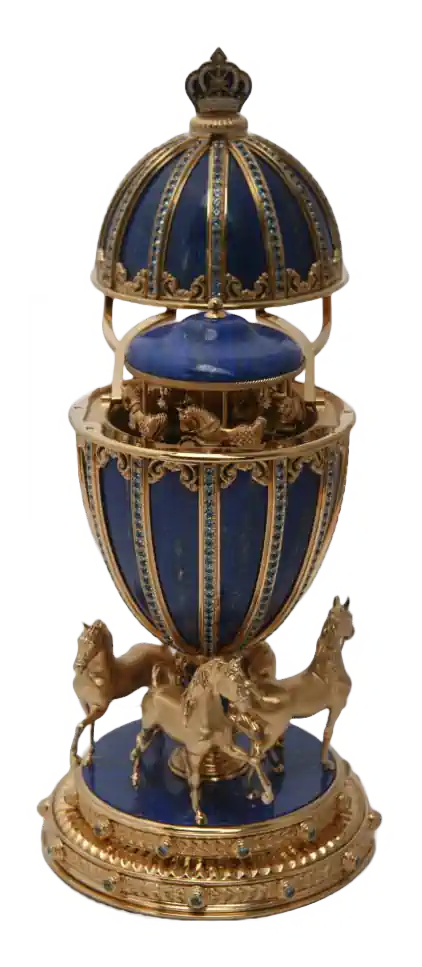Fabergé EggS
History of the Art Form
The style of Fabergé egg is a jeweled egg created by the jewelry firm House of Fabergé, in Saint Petersburg, Russia. As many as 69 were created, of which 57 survive today. Virtually all were manufactured under the supervision of Peter Carl Fabergé between 1885 and 1917. The most famous is his 52 “Imperial” eggs, 46 of which survive, made for the Russian Tsars Alexander III and Nicholas II as Easter gifts for their wives and mothers. Fabergé eggs are worth millions of dollars and have become symbols of opulence.
Prior to 1885, Tsar Alexander III gave his wife Empress Maria Feodorovna jeweled Easter eggs. For Easter in 1883, before his coronation, Alexander III and Maria Feodorovna were given eggs, one of which contained a silver dagger and two skulls. The egg came with messages including “Christ is risen” and “You may crush us–but we Nihilists shall rise again!”
Before Easter 1885, Alexander III’s brother Grand Duke Vladimir Alexandrovich suggested that Peter Carl Fabergé create a jeweled egg. This type of egg is believed to have been inspired by an ivory hen egg made for the Danish Royal Collection in the 18th century. Known as the Hen Egg, it has a 2.5-inch outer enamel shell and a golden band around the middle. The egg opens to reveal a golden “yolk” within, which opened to reveal a golden hen sitting on golden straw. Inside the hen lay a miniature diamond replica of the Imperial crown and a ruby pendant, though these two elements have been lost. It was given to the tsarina on 1 May 1885. The egg cost 4,151 rubles. Six weeks later, the tsar made Fabergé the supplier to the Imperial Court.
Maria was so delighted by the gift that Alexander appointed Fabergé a “goldsmith by special appointment to the Imperial Crown” and commissioned another egg the next year. After that, Peter Carl Fabergé was apparently given complete freedom to design future imperial Easter eggs, and their designs became more elaborate. According to Fabergé family lore, not even the Tsar knew what form they would take—the only requirements were that each contain a surprise and that each be unique. Once Fabergé had approved an initial design, the work was carried out by a team of craftsmen, among them Michael Perkhin, Henrik Wigström, and Erik August Kollin.
After Alexander III’s death on 1 November 1894, his son, Nicholas II, presented a Fabergé egg to both his wife, Alexandra Fedorovna, and his mother, the Dowager Empress Maria Fedorovna. Records have shown that of the 50 imperial Easter eggs, 20 were given to the former and 30 to the latter. Eggs were made each year except 1904 and 1905, during the Russo-Japanese War.


The Dying Swan Egg and Dying Swan Ballet
The Dying Swan (originally The Swan) is a solo dance choreographed by Mikhail Fokine to Camille Saint-Saëns‘s Le Cygne from Le Carnaval des animaux as a pièce d’occasion for the ballerina Anna Pavlova, who performed it about 4,000 times. The short ballet (4 minutes) follows the last moments in the life of a swan and was first presented in St. Petersburg, Russia in 1905. The ballet has since influenced modern interpretations of Odette in Tchaikovsky‘s Swan Lake and has inspired non-traditional interpretations as well as various adaptations.
Inspired by swans that she had seen in public parks and by Lord Tennyson‘s poem “The Dying Swan”, Anna Pavlova, who had just become a ballerina at the Mariinsky Theatre, asked Michel Fokine to create a solo dance for her for a 1905 gala concert being given by artists from the chorus of the Imperial Mariinsky Opera.



